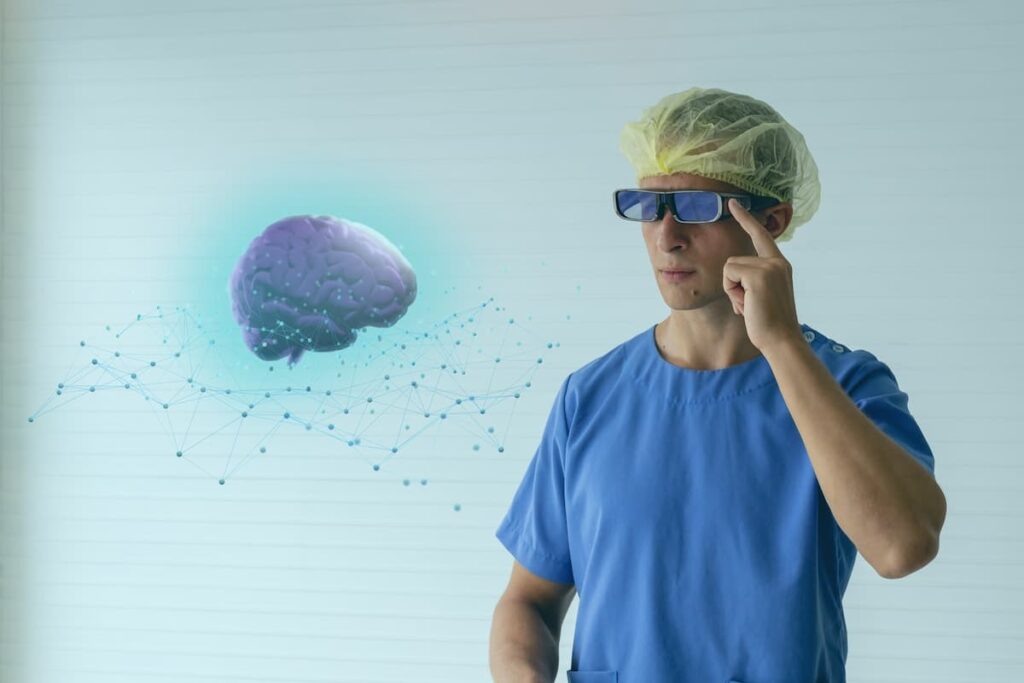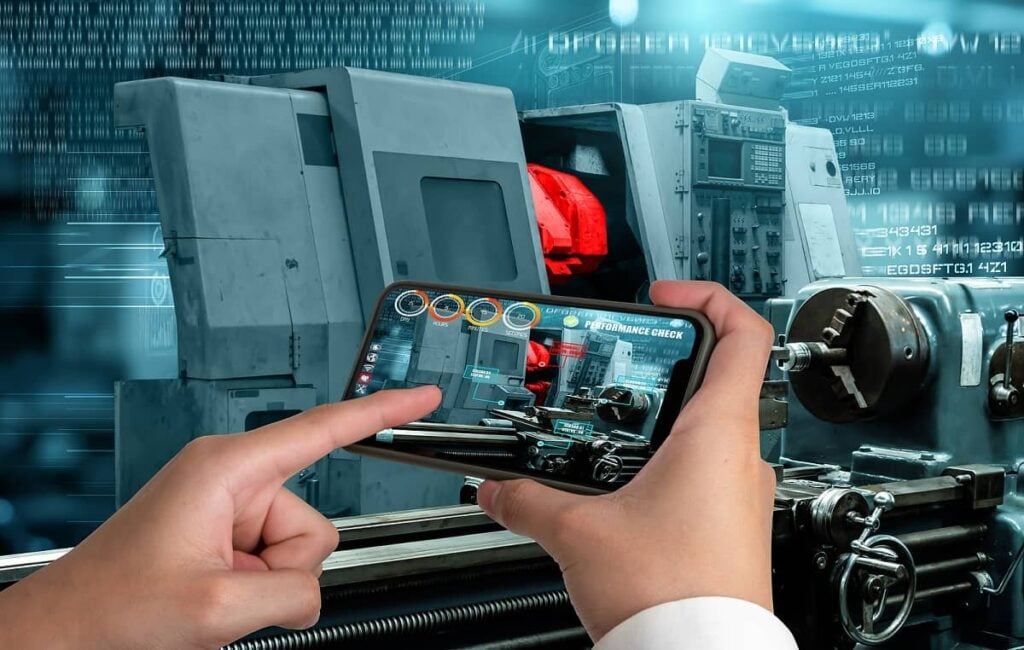10 Augmented Reality Surgery Companies
Table of contents

When you walk into the hospital to receive surgery, you may be walking out with more than you bargained for. Studies show thousands of instances where surgeons leave foreign objects in people’s bodies following surgery. An article by Thought.co on the topic estimates that 4,500 to 6,000 incidents of this type happen every year in the United States alone. Since surgeons can use up to 250 of surgical instruments and tools for a single surgery, the problem is akin to the extra nuts and bolts you have leftover when deciding to service your car yourself instead of taking it to a dealer. You can add one more tool to that list which probably won’t be in danger of being left behind during a surgery – augmented reality headsets.
This spring we attended an excellent medical imaging conference at Stanford where various technologies were showcased including the use of augmented reality to aid surgeons. We first wrote about the use of AR in surgeries several years back in our piece on 3 Startups Using Augmented Reality in Surgery. Around that same time, a paper titled “Recent Development of Augmented Reality in Surgery: A Review” suggested “an increasing interest of surgeons regarding employing augmented reality into surgery,” with the main benefit being that the surgeon doesn’t have to look away from the patient.

So far, applications of AR have been limited by “the essential requisite of preoperative 3D reconstructions of medical images.” Rendering an image isn’t an issue, it’s actually getting the image. Many startups are working to solve this problem, a number of which recently emerged from stealth mode. Let’s start by looking at what’s been going on with the three startups we already covered.
EchoPixel, Augmedics, and TrueVision
Good news for TrueVision Systems which was acquired in December of 2018 by Alcon (ALC), a $28 billion publicly traded company that develops and manufactures eye care products for eye care professionals and their patients. As for EchoPixel, not much to report back in the way of news or fresh funding, but the technology is being used at several dozen hospitals across the United States, so they’ve definitely achieved some traction. Lastly, we have Augmedics, whose CEO and Founder Nissan Elimelech told Bloomberg earlier this year that clinical trials are underway in Israel and “he expects the U.S. Food and Drug Administration to clear Xvision for spinal surgery in early 2019.” The device will be sold “to hospitals at prices comparable to conventional surgical navigation systems, about $200,000 to $300,000.”

Augmedics could make an attractive acquisition candidate for a company like Stryker (SYK) – in particular, their Neurotechnology and Spine division – given they’re already dabbling in high tech areas like robotics and 3D printing. In 2017, Stryker acquired a German augmented reality surgery startup called Scopis which was “specializing in laser-based measuring and endoscopic augmented reality.” This exit bodes well for all the new entrants that are cropping up in this space.
More Augmented Reality Surgery Companies
In addition to the three companies we’ve talked about so far, there are numerous other augmented reality surgery startups out there. This is hardly an exhaustive list, so if your sacred cow didn’t make it into this article, the proper response is to complain in the comments section that we “missed you” and we’ll respond by trying to sell you our content marketing services. Here are some of the startups we came across during our research.

Founded in 2016, New Yawk startup Medivis has raised $2.3 million in funding to develop SurgicalAR, an augmented reality platform that’s also based on Microsoft’s HoloLens. Earlier this year, the device received FDA 510(k) clearance for clinical use in the operating room. Using artificial intelligence to speed up workflows and computer vision for hand-tracking controls, the tool provides improved surgical visualization which should reduce surgical complications and improve patient outcomes.

This year also saw the launch of another AR product, AnatomyX, an enterprise-grade learning platform for the study of human anatomy which supports whatever Magic Leap has finally come to market with.
Founded in 2017, Missouri startup SentiAR has raised $4.4 million in funding so far to develop an idea that seems pretty familiar by now – “a 3D augmented reality platform featuring real-time holographic visualization of the patient’s actual anatomy, “floating” over the patient.” The first iteration “will offer catheter lab clinicians a model of a patient’s heart that floats before their eyes to help plan and execute procedures faster and more accurately.” That’s according to an article by HP – a company that used to innovate but now just watches others innovate – in which SentiAR’s CEO says he “expects the FDA to clear SentiAR’s first offering by the end of 2019.” Considering that the National Institutes of Health was a lead investor in SentiAR, the likelihood of approval seems high.
Founded in 2013, London startup Digital Surgery has raised $21 million in funding to develop “an interactive surgical simulator for healthcare professionals” which they market under the brand name “Tough Surgery.” It’s an app that’s now been downloaded more than 3 million times and contains over 200 simulated procedures across 14 specialties. More than 500,000 surgeons use the app, and it’s also helping “leading Medical Device and Pharmaceutical companies accelerate the surgical competence of their sales reps and medical education attendees.” (One of those companies just happens to be Stryker.) As for the AR element, Touch Surgery was said to be working with DAQRI before they went bust, and has since announced a partnership with Microsoft last October to use HoloLens hardware to “create mixed-reality apps and programs for Microsoft HoloLens to help surgeons as they work.”
Founded in 2016 and also hailing from across the pond, London startup Proximie has raised an undisclosed amount of funding to develop an augmented reality telehealth platform. The solution doesn’t require a special device, but instead just layers digitally created content on a live video stream. It’s all about democratizing access to experts. The platform works over low-speed internet and can be used with almost any device with a camera so that surgeons from around the world can share their expertise with others. “Proximie is currently being used to train surgeons remotely in low-income countries and conflict zones” and “in an educational context to teach medical students at Yale,” says an article by the Augmented World Expo.
Update 04/21/2021: Proximie has raised $38 million in Series B funding to continue pushing into new markets, specifically in the U.S. and Europe as well as invest in new technology capabilities through additional R&D. This brings the company’s total funding to $38 million to date.
Founded in 2016, Seattle startup Proprio has taken in $7 million from investors that include HTC and Intel to develop a revolutionary light field capture and rendering system. (Side note: We previously featured a company called Lytro that was building a light field platform before being acquired by Google.) They use “networked camera arrays, depth-sensing technology and powerful computer graphics processing,” to capture imagery that can then be used in both augmented and virtual realities. Machine learning is being used to improve the real-time capture and render of immersive live volumetric video so that eventually we can move away from legacy tools, including microscopes, loupes, monitors, fluoroscopy, and radiological imagery.

Proprio’s light field platform works with existing medical imaging systems, such as MRIs and CT scans,” says an article by GeekWire which cites collaboration and training as two immediate applications for this technology.
Update 06/17/2020: Proprio has raised $23 million in Series A funding to bring their product to market following FDA approval. This brings the company’s total funding to $30 million to date.
Conclusion
Both augmented reality and virtual reality are finding viable use cases for surgeons, particularly in the area of training and guidance. If your company is doing something interesting in the area of augmented reality surgery, be sure to drop us a note in the comments section below. The melding of digital and physical is now being referred to as “extended reality.” Companies like Vicarious Surgical want to virtually transport surgeons inside a patient’s body using a combination of robotics and virtual reality. With the emergence of 5G, we’ll have enough bandwidth to start offering sophisticated operations like surgery to remote places – a surgeon in New Yawk controls a medical robot in Tarawa. Until then, these companies will be extending reality for surgeons who operate on people in the flesh, leading to better outcomes and happy investors.
Sign up to our newsletter to get more of our great research delivered straight to your inbox!
Nanalyze Weekly includes useful insights written by our team of underpaid MBAs, research on new disruptive technology stocks flying under the radar, and summaries of our recent research. Always 100% free.














